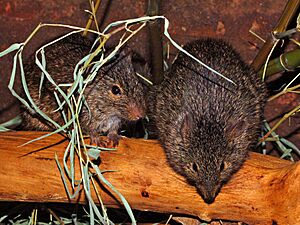African grass rat facts for kids
Quick facts for kids African grass rat |
|
|---|---|
 |
|
| Conservation status | |
| Scientific classification | |
| Genus: |
Arvicanthis
|
| Species: |
niloticus
|
The African grass rat (Arvicanthis niloticus) is a type of rodent. It belongs to the family Murinae, which includes many mice and rats. These rats are common across many parts of Africa.
Contents
Meet the African Grass Rat
The African grass rat is a medium-sized rodent. Its head and body can be about 16 to 20 centimeters long. Its tail is a bit shorter, around 12 to 17 centimeters. These rats usually weigh up to 200 grams. That's about as much as a small can of soda!
Their fur feels rough. The top part of their fur is yellowish with black tips. They also have long yellow or orange hairs on their underside. You might notice a dark stripe running down their back. Their belly is whitish. The areas around their whiskers and eyes are often orange. Their legs are pink. Their tail is covered in hair and is dark on top, yellowish-white underneath.
Where Do They Live?
African grass rats live in many countries across Africa. You can find them in places like Benin, Burkina Faso, Chad, Ethiopia, Ghana, Kenya, Niger, Nigeria, Senegal, Sudan, Tanzania, and Uganda. They also live in Algeria, Egypt, and Yemen. They prefer warm, grassy areas.
Their Home and Lifestyle
These rats like to live in dry or moist savannas. They can also be found near farms, in gardens, and even in urban areas. They are quite adaptable! They often live in places where land is used for farming or grazing animals.
African grass rats usually have babies between June and November. A female rat can give birth to 5 or 6 babies at a time. They can have babies at least 3 or 4 times a year. In the wild, these rats can live for about 2.5 to 3 years.
Helping Science: Studying Diabetes
Scientists use African grass rats to learn about a health problem called Type 2 Diabetes. This is a condition where the body has trouble using sugar for energy. The Nile rat, a type of African grass rat, can get a condition similar to human Type 2 Diabetes.
By studying these rats, scientists can understand how this condition develops. They look at things like how the rats' bodies handle sugar and fat. This research helps them find new ways to prevent or treat Type 2 Diabetes in people.



